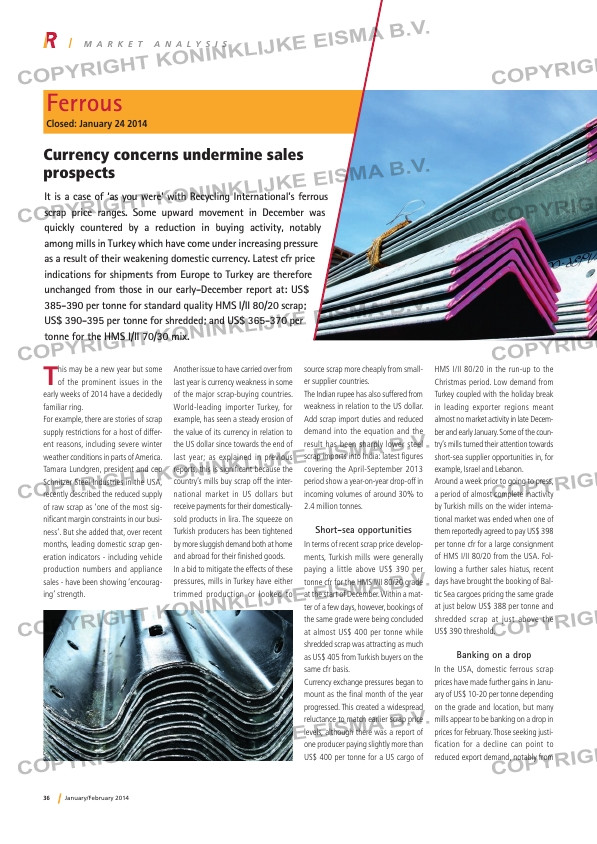Page 36 from: January / February 2014

36 January/February 2014
m a r k e t a n a l y s i s
Ferrous
Currency concerns undermine sales
prospects
It is a case of ‘as you were’ with Recycling International’s ferrous
scrap price ranges. Some upward movement in December was
quickly countered by a reduction in buying activity, notably
among mills in Turkey which have come under increasing pressure
as a result of their weakening domestic currency. Latest cfr price
indications for shipments from Europe to Turkey are therefore
unchanged from those in our early-December report at: US$
385-390 per tonne for standard quality HMS I/II 80/20 scrap;
US$ 390-395 per tonne for shredded; and US$ 365-370 per
tonne for the HMS I/II 70/30 mix.
Closed: January 24 2014
This may be a new year but some of the prominent issues in the
early weeks of 2014 have a decidedly
familiar ring.
For example, there are stories of scrap
supply restrictions for a host of differ-
ent reasons, including severe winter
weather conditions in parts of America.
Tamara Lundgren, president and ceo
Schnitzer Steel Industries in the USA,
recently described the reduced supply
of raw scrap as ‘one of the most sig-
nificant margin constraints in our busi-
ness’. But she added that, over recent
months, leading domestic scrap gen-
eration indicators – including vehicle
production numbers and appliance
sales – have been showing ‘encourag-
ing’ strength.
Another issue to have carried over from
last year is currency weakness in some
of the major scrap-buying countries.
World-leading importer Turkey, for
example, has seen a steady erosion of
the value of its currency in relation to
the US dollar since towards the end of
last year; as explained in previous
reports, this is significant because the
country’s mills buy scrap off the inter-
national market in US dollars but
receive payments for their domestically-
sold products in lira. The squeeze on
Turkish producers has been tightened
by more sluggish demand both at home
and abroad for their finished goods.
In a bid to mitigate the effects of these
pressures, mills in Turkey have either
trimmed production or looked to
source scrap more cheaply from small-
er supplier countries.
The Indian rupee has also suffered from
weakness in relation to the US dollar.
Add scrap import duties and reduced
demand into the equation and the
result has been sharply lower steel
scrap imports into India: latest figures
covering the April-September 2013
period show a year-on-year drop-off in
incoming volumes of around 30% to
2.4 million tonnes.
Short-sea opportunities
In terms of recent scrap price develop-
ments, Turkish mills were generally
paying a little above US$ 390 per
tonne cfr for the HMS I/II 80/20 grade
at the start of December. Within a mat-
ter of a few days, however, bookings of
the same grade were being concluded
at almost US$ 400 per tonne while
shredded scrap was attracting as much
as US$ 405 from Turkish buyers on the
same cfr basis.
Currency exchange pressures began to
mount as the final month of the year
progressed. This created a widespread
reluctance to match earlier scrap price
levels, although there was a report of
one producer paying slightly more than
US$ 400 per tonne for a US cargo of
HMS I/II 80/20 in the run-up to the
Christmas period. Low demand from
Turkey coupled with the holiday break
in leading exporter regions meant
almost no market activity in late Decem-
ber and early January. Some of the coun-
try’s mills turned their attention towards
short-sea supplier opportunities in, for
example, Israel and Lebanon.
Around a week prior to going to press,
a period of almost complete inactivity
by Turkish mills on the wider interna-
tional market was ended when one of
them reportedly agreed to pay US$ 398
per tonne cfr for a large consignment
of HMS I/II 80/20 from the USA. Fol-
lowing a further sales hiatus, recent
days have brought the booking of Bal-
tic Sea cargoes pricing the same grade
at just below US$ 388 per tonne and
shredded scrap at just above the
US$ 390 threshold.
Banking on a drop
In the USA, domestic ferrous scrap
prices have made further gains in Janu-
ary of US$ 10-20 per tonne depending
on the grade and location, but many
mills appear to be banking on a drop in
prices for February. Those seeking justi-
fication for a decline can point to
reduced export demand, notably from
RI-1-2014-MA Ferrous.indd 36 29-01-14 15:23



